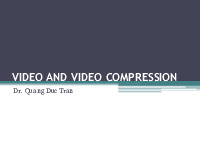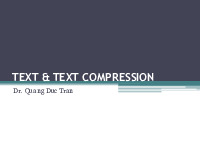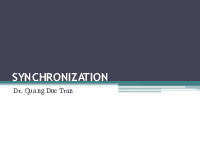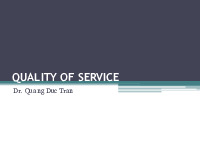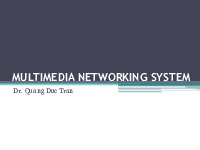












Preview text:
Tutorial (Q&A) Dr. Quang Duc Tran Questions
1) What is band-limited signal?
2) What is the Nyquist sampling theorem? Provide a definition for the Nyquist frequency.
3) What is an anti-aliasing filter?
4) Define the meaning of the term “quantization interval” and
how this influences the accuracy of the sampling process of an analogue signal.
5) Why does the quantization error gets worse with fewer bits to present an analogue signal? Questions
6) Explain the run length coding with an example.
7) Explain the Huffman coding with an example.
8) Explain the LZW coding with an example.
9) What are DC and AC coefficients in image compression?
10)What characteristics of eye are exploited in the quantization of the image? Questions
11) Explain how the block preparation is performed in an image compression phenomenon?
12) Explain the process vectoring using a zigzag scan diagram.
13) Why is DCT used in transform encoding?
14) In an image compression explain where information loss can occur?
15) What is differential coding? Questions
16) Explain the term “critical bandwidth” and identify how this also varies with frequency.
17) Explain the meaning of the term “frequency masking”.
Illustrate on your graph the masking effect of a loud signal on neighbouring signals.
18) Explain the meaning of the term “temporal masking”. What
are the implications of exploiting this effect?
19) Explain the operation of a basic DPCM signal encoder and
decoder. Include in your explanation the source of errors that can arise. Questions
20)Explain how a basic ADPCM scheme obtains improved
performance over a DPCM scheme.
21) Explain how better sound quality-for the same bit rate-can
be obtained using a sub-band coding ADPCM. Give
examples of the bit rates used for the lower and higher sub-
bands and state an application of this type of codec.
22) Explain the meaning of I, P and B frames of and the reasons for their use.
23) Explain the terms of motion compensation and motion
estimation in relation to the P-frames in video compression. Questions
24)Explain group of pictures in relation to video
compression? What happens in a fast moving scene. 25)What is a moving JPEG?
26)Why do we use video object planes in MPEG-4?
27)What is FDDI? Describe the pros and cons of FDDI?
28)Discuss the network requirements for multimedia communication. Questions
29) Explain why the ATM packet size is 53 Byte.
30)What are MMDS and LMDS? How is MMDS different from LMDS.
31) Explain the Round Robin packet scheduling mechanism.
32) Explain the term “Tail Drop” in network congestion. Why
does Tail Drop lead to TCP global synchronization.
33) What is IntServ? What is the main drawback of IntServ? Questions
34) Explain the terms “TSPEC” and “RSPEC” in Integrated Services
35) Describe the Token Bucket algorithm. What are the advantages of
Token Bucket over Leaky Bucket.
36) Describe the RSVP mechanism? Why is RSVP receiver-oriented?
37) Explain the terms “Stop-and-Wait ARQ”, “Go-back-N ARQ” and “Selective ARQ”
38) Explain the terms “Expedited Forwarding PHB” and “Assured
Forwarding PHB” in computer networking.
39) Discuss the issues of multimedia synchronization. Questions
40) Discuss the reference model for multimedia synchronization.
41) Why is synchronization in a distributed environment more
complex than in a local environment?
42) How is the synchronization specification delivered between the source and the sink?
43) What is multi-step synchronization?
44) Explain the term “jitter”. Explain how the use of timestamp may overcome the jitter problem.
45) Explain why the real –time data can not be TCP? Questions
46) What is RTP? What are the main functions of RTP?
47) What is the marker bit in RTP header? What is the market bit good for?
48)What is RTCP? What are the main functions of RTCP?
49) Explain why the fraction of the RTCP traffic must be limited? 50) What is FEC?
How does FEC work? What are the disadvantages of FEC? Questions
51) How does interleaving increase the robustness of FEC?
What are the disadvantages of interleaving?
52) What is RTSP? Explain the operation of RTSP. How is it compared with HTTP streaming?
53) What is the relationship between RTP, RTCP, and RTSP?
54) Describe the basic network elements of H.323.
55) Describe the basic network elements of SIP. Questions
56)How do RSTP, RTP and H.323 relate to one another?
57)What are the differences between VoIP and PSTN?
58)Discuss the different VoIP scenarios.
59)How are the Video Conferences (VC) classified?
60)What are the advantages and disadvantages of the
distributed VC over the centralized VC?
